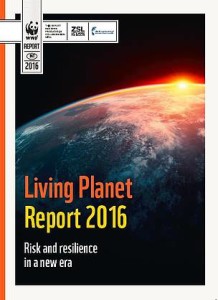Living Planet Report 2016 (WWF)
 This report sets out how we are losing biodiversity at a faster rate than ever. According to the report global populations of fish, birds, mammals, amphibians, and reptiles have already declined by 58% between 1970 and 2012. And this trend is expected to continue due to our overexploitation of ecological resources.
This report sets out how we are losing biodiversity at a faster rate than ever. According to the report global populations of fish, birds, mammals, amphibians, and reptiles have already declined by 58% between 1970 and 2012. And this trend is expected to continue due to our overexploitation of ecological resources.
“Our use of natural resources has grown dramatically, particularly since the mid-20th century, so that we are endangering the key environmental systems that we rely upon.” The top threats to species are directly linked to human activities, including habitat loss, degradation, and overexploitation of wildlife.
The impact of human activity on the environment means we are now in the “Anthropocene” which “might be characterized by the world’s sixth mass extinction event.” During this time “our climate has changed more rapidly, oceans are acidifying and entire biomes are disappearing – all at a rate measurable during a single human lifetime”.
The Ecological Footprint “represents the human demand on the planet’s ability to provide renewable resources and ecological services. Humanity currently needs the regenerative capacity of 1.6 Earths to provide the goods and services we use each year.”
While all countries are contributing to the global demand on nature high-income countries have an ecological footprint that is almost three times that of middle-income countries, and about six times that of low-income countries.
If current trends continue, unsustainable consumption and production patterns will likely expand along with human population and economic growth. The growth of the Ecological Footprint, the violation of Planetary Boundaries and increasing pressure on biodiversity are rooted in systemic failures inherent to the current systems of production, consumption, finance and governance. The behaviours that lead to these patterns are largely determined by the way consumerist societies are organized, and fixed in place through the underlying rules and structures such as values, social norms, laws and policies that govern everyday choices.
In exploring the root causes of environmental degradation the report argues “systems thinking can help to define root causes of human behaviour that lead to unsustainable consumption patterns, destructive production patterns, malfunctioning governance structures and short-term focused economic planning.” It gives the example of food where root causes include “the poverty trap, concentration of power, and lock-ins to trade, agricultural research and technology.”
It proposes the following measures to change business as usual:
Transitioning toward a resilient planet entails a transformation in which human development is decoupled from environmental degradation and social exclusion. A number of significant changes would need to happen within the global economic system in order to promote the perspective that our planet has finite resources. Examples are changing the way we measure success, managing natural resources sustainably, and taking future generations and the value of nature into account in decision-making.
This transition requires fundamental changes in two global systems: energy and food. For the energy system, a rapid development of sustainable renewable energy sources and shifting demand toward renewable energy are key. For the food system, a dietary shift in high-income countries – through consuming less animal protein – and reducing waste along the food chain could contribute significantly to producing enough food within the boundaries of one planet. Furthermore, optimizing agricultural productivity within ecosystem boundaries, replacing chemical and fossil inputs by mimicking natural processes, and stimulating beneficial interactions between different agricultural systems, are key to strengthening the resilience of landscapes, natural systems and biodiversity – and the livelihoods of those who depend on them.
Read report
————————————
This summary was prepared by Why Green Economy?. The views expressed have been paraphrased. See the original source for more information.

Leave a Reply